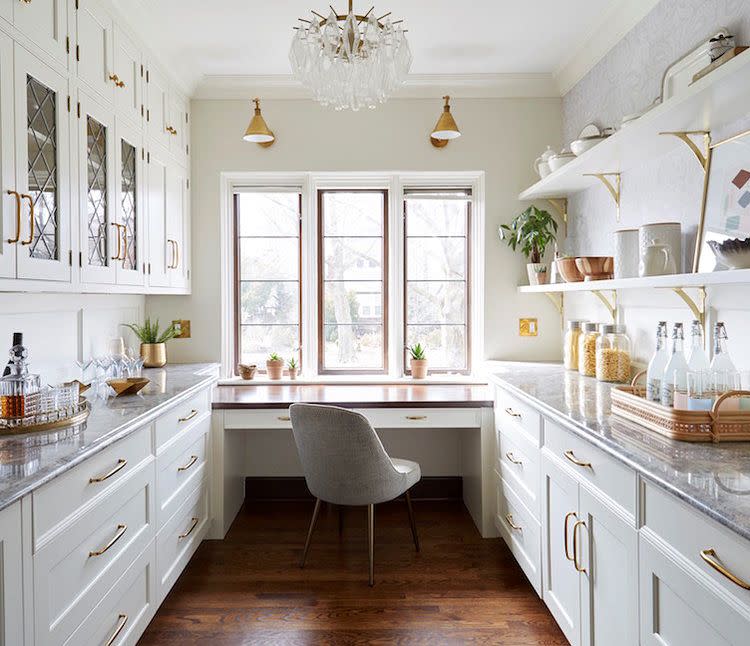Sculleries Are Making a Comeback—Experts Explain Why You Should Consider Adding One to Your Home
Typically thought of as an overflow kitchen, sculleries were common back in the day—but are making a resurgence in kitchen design now.

The word "scullery" may not be a term you’ve heard thrown around very often when it comes to home design, especially since the concept of one is fairly dated. Some older homes may already have sculleries, but more designers are incorporating this room into modern design plans because of their functionality. While formerly considered a sign of wealth, having a scullery today isn’t as much of a status symbol as it is an extension of the kitchen.
We asked experts to explain what this mysterious little room is, how it differs from spaces like a butler's pantry, and tips for using a scullery if you have one—or are thinking of adding it to your home in the future.
Meet Our Expert
Emma Kemper, interior designer and founder of Emma Beryl Interiors
John A. Buscarello, ASID, certified interior designer and professor at the New York School of Interior Design
Mary Patton, interior designer and founder of Mary Patton Design
Related: 34 Beautiful, Functional Kitchens to Inspire Your Own
What Is a Scullery?
As a small room adjacent to the kitchen, a scullery has historically been used for cooking preparation and cleaning up, leading it to be commonly classified as an "overflow kitchen." It may also be used for storing kitchenware like plates, bowls, and silverware, plus kitchen gadgets and appliances. Sometimes, it has been used as a space for other housework like laundry and ironing.
The Difference Between a Scullery and a Butler's Pantry

Sculleries and butler's pantries serve similar purposes, but there are a few key differences. "A scullery historically served as a utility space for washing and cleaning kitchen items," says Emma Kemper, interior designer and founder of Emma Beryl Interiors. "It is frequently equipped with a sink and focused on practical tasks. In contrast, a butler's pantry is more of a storage and serving area, often located between the kitchen and dining room, facilitating the seamless serving of meals.”
A butler’s pantry is devoted to getting meals ready to serve so the actual kitchen remains polished. These were typically found in wealthier homes, estates, and manors and offered a convenient location to store the family’s fine china. Sculleries remain focused on the actual preparation of the meal and cleaning. "The scullery seems to be more 'back-of-the-kitchen,' perhaps akin to a mud room for the kitchen with a lot more storage," says John A. Buscarello, ASID, certified interior designer and professor at the New York School of Interior Design.
Related: 11 Kitchen Features That Will Make Your Life Easier
Tips for Having a Modern-Day Scullery
If your home has a scullery room attached to your kitchen, or you're thinking of remodeling and adding this useful space, keep these tips in mind for a fully functional, modern scullery.
Keep It Practical
Kemper suggests leaning into the practicality of having a scullery in your home today. "For a modern scullery, prioritize functionality with a well-equipped, organized space for dishwashing and food preparation," she says. This can mean using the space for cooking to keep your actual kitchen free of mess, especially if you’re entertaining. You can also consider storing your appliances in the space, like blenders, air fryers, and coffee makers, or maybe even having a secondary freezer housed in the scullery for overflow.
Mary Patton, an interior designer and founder of Mary Patton Design, even goes as far as acknowledging a scullery as a fully secondary kitchen. "With its origin from the Victorian area, this idea of having a second utilitarian kitchen space is pretty incredible," says Patton. "Counter space for prep work and small appliances, or a second sink and dishwasher to stash dirty dishes during a party is truly a luxury anyone that loves to cook or entertain would be thrilled to have."
Related: 12 Kitchen Organizing Mistakes Experts Say to Avoid
Transform It Into a Home Bar
Patton has converted sculleries into modern-day home bars for several kitchen projects. With the right storage solutions, you can make room for a wine fridge and use existing cabinets to store glasses and flutes. You can also build a liquor cabinet, store gadgets in drawers, and use it for your bar supplies by stashing drink garnishes like olives, herbs, and fruits.

Incorporate Current Design Trends
Lastly, Patton recommends incorporating modern design as much as possible. "Historically, the scullery was only for function, but today, I would design one with just as much style as the main kitchen," she says. Your scullery can be an extension of the design in your kitchen or have a whole personality of its own. Treat it like any other room in your home: a canvas to add character that is uniquely yours while still incorporating modern design trends that will elevate your space.
Read the original article on Martha Stewart.

